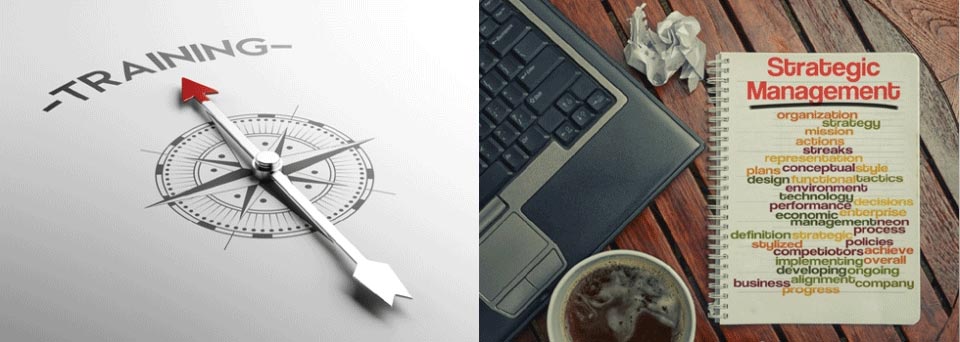Date: 21st May, 2015:ASSOCHAM Summit on “India: Innovative, Creative & Inclusive”
Venue: Hotel Imperial
This summit was convened by ASSOCHAM to get industry, political and academia leaders to discuss regarding the concept on innovation and creativity in the economy as India moves forward. Also this creativity must be inclusive. This write-up examines the various sessions held and highlights the salient points which emerged out of those.
Plenary Session
This session consisted of 6 panel members. The panel members were as follows:
|
S. No. |
Name |
Designation |
Organization |
Session Role |
|
1 |
Ms. Sushma Paul Berlia |
Chairperson |
ASSOCHAM Economic Affairs Council |
Welcome & Theme Address |
|
President |
ApeejayStya&Svran Group |
|||
|
2 |
Dr. M. O. Garg |
Director General |
CSIR |
Keynote Address |
|
3 |
Dr. Anil K Gupta |
Professor |
IIM Ahmedabad |
Keynote Address |
|
Founder |
Honey Bee Network |
|||
|
Executive Vice Chair |
National Innovation Foundation |
|||
|
4 |
Ms. Monica Magnusson |
Vice President- Strategy & Portfolio Management |
Ericsson AB |
Industry Remarks |
|
5 |
Dr. A.P.J. Abdul Kalam |
Honourable Former President |
Government of India |
Address by Chief Guest |
|
6 |
Mr. D.S. Rawat |
Secretary General |
ASSOCHAM |
Vote of Thanks |
SushmaBerlia
This speaker delivered the theme address introducing us to what were the major points for discussion at the summit. She spoke about how innovation at work can increase productivity multifold. As India’s economy is poised to reach new highs this century, innovation and creativity are necessary to continue to fuel the same. However innovation must be inclusive and not restrictive. Also it must be sustainable for the environment.
Dr. M.O. Garg
This speaker spoke about how CSIR is actually an organization older than the country India itself. Thus it was made before India was made and many decades before the term- ‘Make in India’- was coined. Thus the political and scientific leaders of this country had the foresight to envisage a future of scientific prowess so far back in time. Now it is time we leverage the skill sets we have and develop further in this field of scientific research.
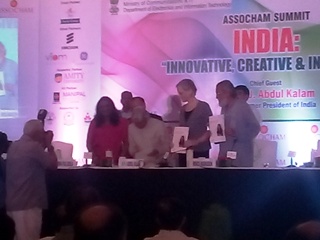
Dr. Anil K Gupta
Dr. Gupta mentioned 3 words which he feels are the cornerstone to how India must attempt frugal innovation. Those words being- affordable, circular and accessible. By affordable, he means that innovation must not make the product or service more expensive. It ought not to be high end technology alone where the R & D charge is too high and an organization needs to recover that much which will be borne by customers. This kind of innovation is needed, but the need of the hour is the frugal innovation. It must also be circular which means that a product must be recyclable / reusable in the future. A Re. 1 sachet of shampoo may appear inexpensive and affordable, yet the cost on environment of that plastic packet is enormous. With many such products, our entire landscape will be filled with such products. Finally they must be accessible to all and not the preserve of the elite alone. This will ensure that we all become part of this process of frugal innovation.
The speaker also warned us regarding the type and quality of products that are easily accessible. He speaks about the state of Gujarat where 605 women are anemic. This in spite of relatively high income levels in that state in comparison with the rest of the country. These products are iron deficient which leads to anaemism among the consumers. Even the children are malnourished due to the quality of consumption rather than quantity available.
The Hindi word Jugaad has often been praised as a sort of Indian frugal innovation. Yet the speaker says that Jugaad is a mental sickness which has curbed India’s growth potential in manufacturing. Today a simple India made mobile phone charger once bought, does not guarantee to connect with the plug socket. This is because of the poor quality of manufacturing where producers only see short term gains and miss out on the bigger picture due to the Jugaad mentality. This country is capable of high level weapons manufacturing and a space project to study the moon, yet simple things are being ignored.
Dr. Gupta then provided us with what he termed as the Innovation Playground Matrix. The matrix is as follows:
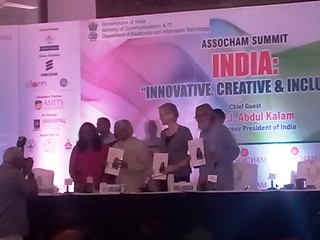
Ostrich is the position which is both inside out and outside in low. Toyota can be described as an example of an organization being a pollinator. It never wanted to keep the patents within, opened them all up thus reducing overall cost. Tesla can be considered another such example. A sponge takes a lot in but does not contribute externally. A DBDB is perfect in every sense. The speaker described the DBDB situation as – DilBadaDimagBada- to borrow phrases from Hindi.
The speaker then went on to describe his recent visit to a tribal area in the north eastern state of Tripura. There he interacted with tribal people and purchased handicrafts from them. He even walked on man-made bridges of completely organic plant material created by local people. He then spoke about 5 parameters of include innovators. These parameters are- spaces, sectors, seasons, socials segments and skills (& knowledge). Dr. Singh then gave us a clarion challenge. He asked aloud for local solutions, for example creating a local Wi-Fi network on individual hillocks in Tripura.
Some months back he was in Purilia district in West Bengal. The area is famous for terracotta statues. He saw a number of statues especially of horses. Some of the really good ones he found intriguingly perched under trees without owner anywhere in sight. So he asked one of the craftsmen why such was the case. The local craftsman explained that he had in fact put up the best ones under tree so that the young people in the village could peer towards them and realize the challenge on their hands. Their generation needs to go one better and improve the art of statue making. The speaker concludes this is a version of open source innovation. These kind of local solutions are needed.
Monica Magnusson
Ms. Magnusson began her talk by describing how during the peak of summer back home, the temperature at this point is a measly 5 degree centigrade. Thus not just her heart but entire body has warmed up to India. Continuing on the Sweden theme, she informed us that Sweden is a country of barely 9 million people staying in such sub-arctic conditions year on. The only way people could have survived in such weather is through innovation. Innovation has been a constant part of Swedish life ever since the age of the Vikings. She then reaffirmed that she was not a big fan of the Viking method which often meant a quick escape. However, she appreciated their stubbornness in overcoming the environment and establishing a flourishing civilization. Due to this requirement of a quick escape, their ships were designed to be flat bottomed. Sweden’s present rank is 3 and has always hovered in the top for in the Global Innovation Index. Dynamites and safety belts are only 2 of the inventions credited to Swedes.
The speaker now moved on to speaking about her organization i.e. Ericsson. It was founded in 1876. In the telecom industry, it is a global leader having also achieved up to 4G efficiency in mobile internet but now 5G is being explored. In India, Ericsson has been there since 1904. Spotify is another major Swedish innovation. She concluded by saying that while 2 G may have been a European venture, but 5 G is a truly global collaboration with India included in the list of collaborators.
Dr. A.P.J. Abdul Kalam
Dr. Kalam was the chief guest of the day and the major attraction for the entire audience. A substantial percentage of the delegates only came to hear him speak. He began his talk by continuing from where the previous speaker from Sweden left off. He spoke about Sweden being a country where 96% of waste generated gets recycled. In fact Sweden imports 800 million tonnes of trash to convert to energy. He then gave a cycle of innovation. As per the cycle, economic development is powered by competitiveness which is powered by knowledge which is further powered by technology which is in turn powered by innovation. Thus innovation marks the genesis for economic development for any nation. He then discussed from the other way round by saying that creative leadership leads to a healthy working environment which powers employee satisfaction which eventually leads to enhanced employee productivity. Dr. Kalam concluded by speaking about the various attempts that were made to launch rocket while he was at ISRO. A number of failures we mocked at by the media suggesting that taxpayers’ money had been wasted, dumped into the Bay of Bengal. Finally though tries succeeded and now India has a worldwide recognized space research centre.
D.S. Rawat
This speaker delivered the Vote of Thanks for the session. He summed up some of the points delivered and ensured that the main points discussed would be further taken forward by ASSOCHAM in the quest to enhancing innovation in the country.
This event was followed by the Networking Tea Break.
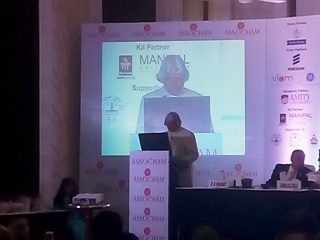
Technical Session: Building an Ecosystem for Innovative India
This session consisted of 6 panel members. The panel members were as follows:
|
S. No. |
Name |
Designation |
Organization |
Session Role & Topic |
|
1 |
Dr. ParveenArora |
Sc-G & Head, CHORD |
DST |
Chair & Moderator |
|
2 |
Dr. PrabhatRanjan |
Executive Director, TIFAC |
DST |
Government Perspective |
|
3 |
Mr. ManasviSrivastava |
Director, Trade, India, South & South East Asia |
Microsoft |
Creating and Promoting an Innovative & Creative Ecosystem : Role of Policy |
|
4 |
Dr. Maninder Singh |
VP & Head of Talent & Development |
Viom Telecom |
Human Resource Issues in Innovation: Emphasis on Skilled Manpower |
|
5 |
Dr. B.C. Das |
Chairman & Chair-Professor |
Amity Institute of Molecular Medicine & Stem Cell Research |
Encouraging Creativity and Innovations: Role of Universities and Education Sector |
|
6 |
Mr. VijayaSarathy |
CoE Leader Business Anlytics PACE/ India IP Leader |
GE |
Role of IPRs in Technology Development |
|
7 |
Mr. G Raj Narayan |
Founder & MD |
Radel Advanced Technology |
Human Resource Issues in Innovation: Emphasis on Skilled Manpower |
|
8 |
Mr. Sanjay Sharma |
Managing Director |
Accenture Digital |
Moving Towards Inclusive Innovative India |
Dr. ParveenArora
As the moderator of this discussion, this speaker introduced the key points to be discussed. He introduced each of the panel members, their respective organizations and their individual accomplishments.
Dr. PrabhatRanjan
This speaker spoke about how his firm has a Technology Vision 2035. This is in line with the government’s Vision 2020 and Beyond. But this one is specifically to do with technology. There are three ways for India to reach the goals of scientific self-sustainability. One is by galloping, another approach is by cantering and finally by trotting. The decision lies with the people and the pace of work at various industries. There is a technology roadmap which his organization has created to ensure these activities are possible.
We tend to compare with China. A simple horizon scanning though does not portray a very positive picture for India. Just as an example there are 400,000 3D printers at various Chinese primary schools. In India though we continue on the path of rote learning. This greatly limits thinking capacity.
There is a massive bias against physical labour in our country. Students at school / college level ignore lab sessions. In computer engineering courses, hardware is ignored in favour of software. In fact non computer students, who may have studied engineering in some other field, are keen on taking up computer based cushy jobs in corporates. Engineers above all do not want to work in manufacturing.
The speaker suggested that every child must be made to do a minimum of 1 hour of physical work per week. This will instill a sense of dignity for manual labour. The work may include gardening, washing clothes, sweeping rooms, dusting the house etc. One must never see the disability but the abilities among young people. With focus on abilities, the accelerometer further registers a rise.
His firm is also engaged in helping patent holders get financial assistance from SIDBI. All of it was done free of cost. They have partnered with NGO called Srijan for achieving this. Large industries need to take up leadership on the scientific development and innovation part. The problem with India at a macro level and with states like Chhattisgarh (where he has worked extensively) at micro level are quite similar. These states possess massive mineral deposits yet choose to export them to other parts of the country or abroad without any value addition.
Finally the speaker concluded by speaking about certain practices among the student community. They all want jobs and placements at big firms. Often these large firms are not conducive for learning as they form a minor cog in them. Alternatively, working in smaller firms can vastly expand the learning abilities as in them the new recruit is a valuable cog from day one.
ManasviSrivastava
The speaker feels that innovation does not necessarily mean a new product. It may instead mean simply an existing product being delivered in a new manner. In the year 2013, there was a 9% increase in patent applications in the USA. In India too patents granted in 2013 were at an all-time high of 4126 but still much less than USA which touched 302,948 in the same year. There is no one-size-fits-all formula to ensure innovation in a country.
Dr. Maninder Singh
The speaker feels that innovation is a part of human psyche. A look at the recent IIN ads which have divided the nation, can clearly show how a bit of innovation can solve major problems. Sans innovation, yesterday’s performers have become today’s laggards. He also agrees with the earlier statement on how the Jugaad mentality kills off systematic approach. Now the basic buzzwords have branched off to roti, kapda, makanaurinternet which has become intrinsic to the knowledge driven modern world.
Dr. B.C. Das
This speaker laments the relatively low level of investment in higher education in India. Most of the education budget is eaten off at the primary school level. In spite of this attitude, India is still ranked 7th in the world in terms of patents awarded annually. This trend has been ongoing for a few years now and is not a flash in the pan of any particular year. He then spoke about his own organization- Amity University- and how they have been leaders in the education sector in terms of innovation. Especially towards developing a sound sustainable environment, Amity has made substantial progress.
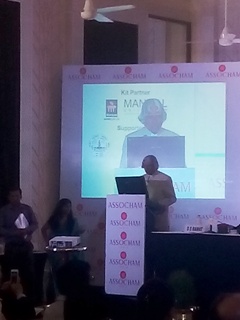
VijayaSarathy
Mr. VijayaSarathy spoke about the impact of IPRs and how they can be used at industry level. Especially for agriculture this is a burning topic. Yet it does not get the importance at international forums it must do.
G Raj Narayan
Mr. Raj Narayn being a design engineer, gives an extremely pertinent example from the Jaguar Land Rover (JLR). JLR was purchased by the Tatas, yet we as a country are not utilizing the core competence of such an acquisition. We must study how it was made and then try to re-engineer the same in an Indian brand. China has been following this principle for years. The idea is to – design, create and go forward.
Sanjay Sharma
This speaker gave a very good version of how innovation works in the real world. He recalled a conversation which he had with his senior many years back. He was told to either innovate or become an excellent copycat. In fact the most successful innovators may not be those who actually initiated the product but the ones who could find a model to bring it to scale and at a fast pace. The speaker cites the example of the White Revolution which took place in India. The entire process totally revolutionized every segment of the value chain. Another similar example could be that of the gaming industry in Japan. While many players did not innovate, they were successful due to the fact that they could scale down their operations in a gaming mad country. Many more people can thus now use them.
The SAS code from North Carolina in the USA has faced a similar story. Innovated but soon could not match the copycats in terms of scalability and ultimately cost. Thus there are few innovators, many more imitators. We need imitators to achieve Returns on Investment (RoI).
This session was followed by the Networking Lunch.
The business & market research department is increasingly perceived as being not just responsible for the organization of research, but also for sharing and distributing knowledge and expertise in a credible and convincing way.
[csblink]

